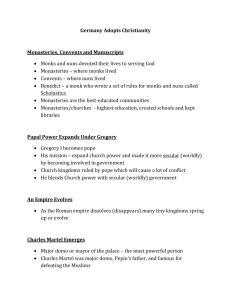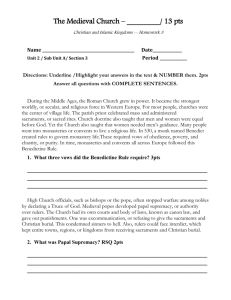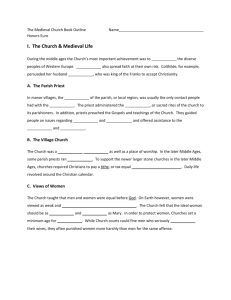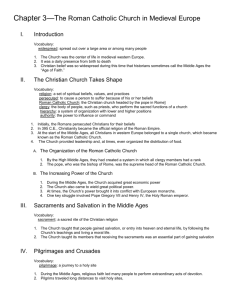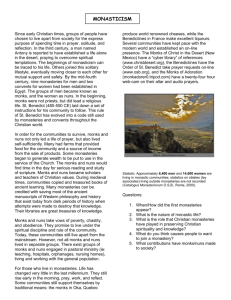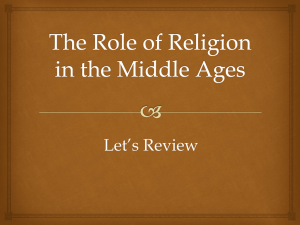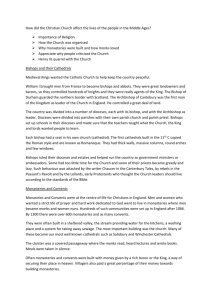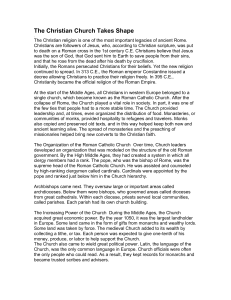Reading - Mr. Wisell`s Global History Web Site
advertisement
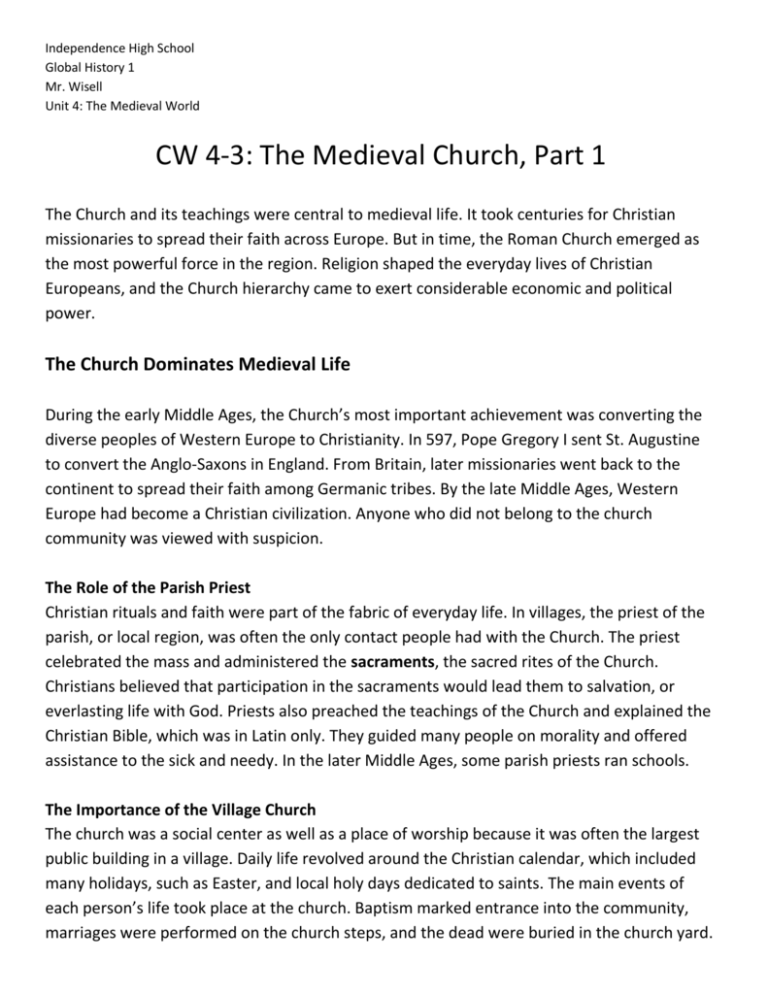
Independence High School Global History 1 Mr. Wisell Unit 4: The Medieval World CW 4-3: The Medieval Church, Part 1 The Church and its teachings were central to medieval life. It took centuries for Christian missionaries to spread their faith across Europe. But in time, the Roman Church emerged as the most powerful force in the region. Religion shaped the everyday lives of Christian Europeans, and the Church hierarchy came to exert considerable economic and political power. The Church Dominates Medieval Life During the early Middle Ages, the Church’s most important achievement was converting the diverse peoples of Western Europe to Christianity. In 597, Pope Gregory I sent St. Augustine to convert the Anglo-Saxons in England. From Britain, later missionaries went back to the continent to spread their faith among Germanic tribes. By the late Middle Ages, Western Europe had become a Christian civilization. Anyone who did not belong to the church community was viewed with suspicion. The Role of the Parish Priest Christian rituals and faith were part of the fabric of everyday life. In villages, the priest of the parish, or local region, was often the only contact people had with the Church. The priest celebrated the mass and administered the sacraments, the sacred rites of the Church. Christians believed that participation in the sacraments would lead them to salvation, or everlasting life with God. Priests also preached the teachings of the Church and explained the Christian Bible, which was in Latin only. They guided many people on morality and offered assistance to the sick and needy. In the later Middle Ages, some parish priests ran schools. The Importance of the Village Church The church was a social center as well as a place of worship because it was often the largest public building in a village. Daily life revolved around the Christian calendar, which included many holidays, such as Easter, and local holy days dedicated to saints. The main events of each person’s life took place at the church. Baptism marked entrance into the community, marriages were performed on the church steps, and the dead were buried in the church yard. Villages took pride in their church buildings and decorated them with care. In later medieval times, prosperous communities built stone churches rather than wooden ones. Some churches housed relics, which could be possessions or remains of saints. Many peoples made pilgrimages, or religious journeys, to pray before the relics. The Church required Christians to pay a tithe, or tax equal to a tenth of their income. In the early Middle Ages, the tithe supported the local parish. Later, increasing amounts of money were sent to Rome. The Rise of Cathedrals Bishops, who supervised parish priests, managed larger churches called cathedrals. By the 1100s, communities used new technology to build huge cathedrals in the ornate, buttressed form known as the Gothic style. These magnificent buildings were a source of pride to the communities that built them. Cities all over Europe competed to build grander, taller cathedrals. Members of the Church contributed money, labor, and skills to help build these monuments glorifying their god. Church Attitudes Toward Women Church doctrine taught that women and men were equal before God. But on Earth, women were viewed as weak and easily led into sin. Thus, they needed the guidance of men. At the same time, the Church offered a view of the ideal woman in Mary, whom the Church believed to be the modest and pure mother of Jesus. Many churches were dedicated to the “mother of God” and “queen of heaven.” Men and women asked Mary to pray to God on their behalf. On the one hand, the Church tried to protect women. It set a minimum age for marriage. Church courts could fine men who seriously injured their wives. Yet they often punished women more harshly than men for similar offenses. Monasteries and Convents During the early Middle Ages, some men and women withdrew from worldly life to the monastic life. They became monks and nuns. Behind the walls of monasteries and convents, they devoted their entire lives to spiritual goals. Monastic Life: The Benedictine Rule About 530, a monk named Benedict organized the monastery of Monte Cassino in central Italy. He created rules to regulate monastic life. In time, the Benedictine Rule was used by monasteries and convents across Europe. Under the Benedictine Rule, monks and nuns took three vows. The first was obedience to the abbot or abbess who headed the monastery or convent. The second was poverty, and the third was chastity, or purity. Each day was divided into periods for worship, work, and study. Benedict required monks to work in the fields or at other physical tasks. As part of their labor, monks and nuns cleared and drained land and experimented with crops. Because they developed better agriculture methods, they helped improve the economy of the Middle Ages, which was based on farming. Service and Scholarship In a world without hospitals or schools, monasteries and convents often provided basic health and educational services. Monks and nuns looked after the poor and sick and set up schools for children. They gave food and lodging to travelers, especially to Christian pilgrims traveling to holy shrines. Some monks and nuns became missionaries. These missionaries spread Christianity throughout western and central Europe during the early Middle Ages. Monasteries and convents also performed a vital role in keeping learning alive. Their libraries contained Greek and Roman works, which monks and nuns copied as form of labor. Educated monks and nuns also wrote and taught Latin, which was the language of the church and educated people. Opportunities for Women Although women could not become priests, many did enter convents. There, capable women could escape the limits of society. In the 1100s, Abbess Hildegard of Bingen composed religious music and wrote books on many subjects. Because of her mystical visions, popes and rulers sought her advice. In the later Middle Ages, the Church withdrew rights that nuns had once enjoyed, such as preaching the Gospels, and placed most independent convents under the control of Church officials. It frowned on too much learning for women, preferring them to accept Church authority.

